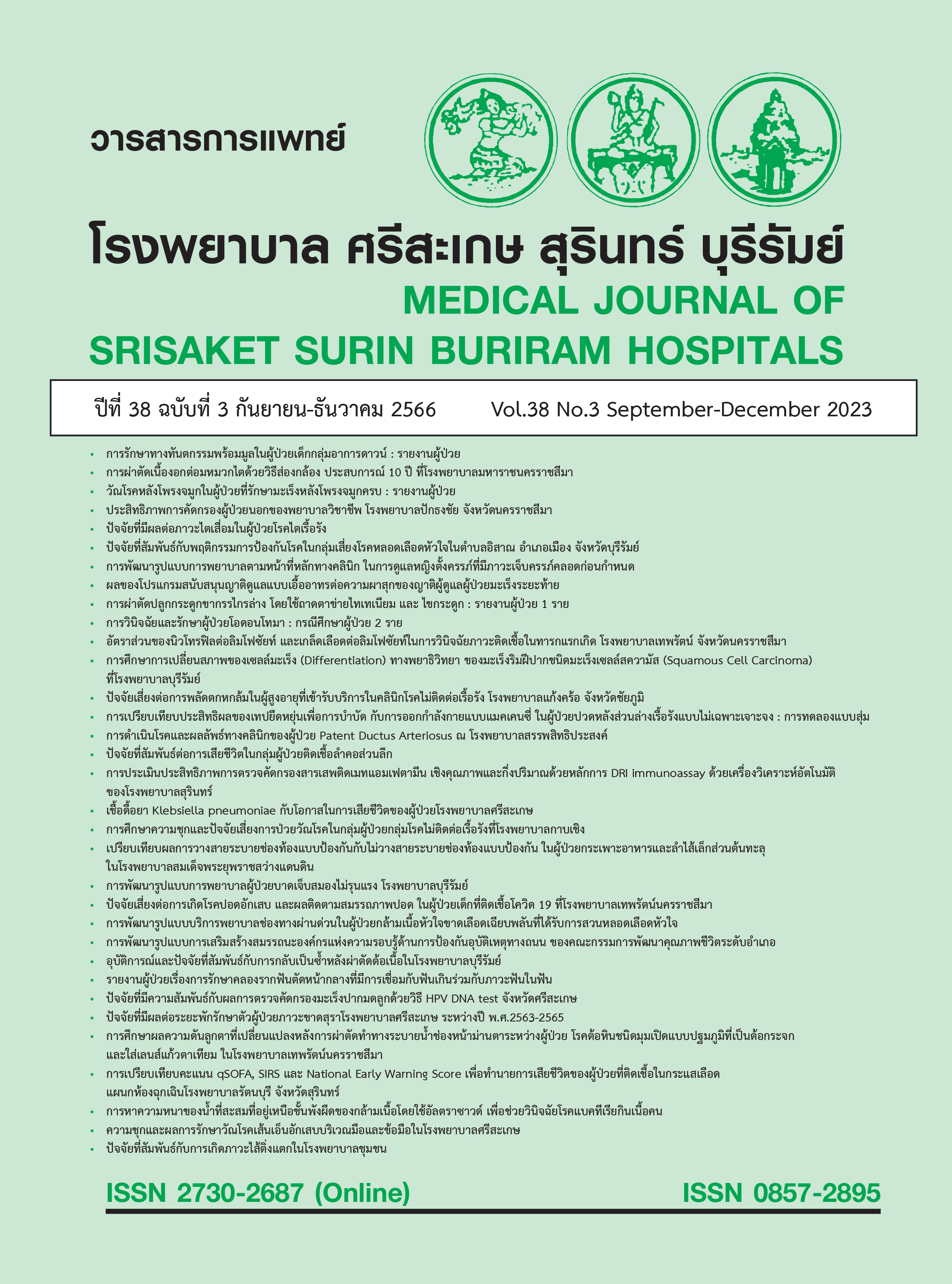การเปรียบเทียบคะแนน qSOFA, SIRS และ National Early Warning Score เพื่อทำนายการเสียชีวิตของผู้ป่วยที่ติดเชื้อในกระแสเลือด แผนกห้องฉุกเฉินโรงพยาบาลรัตนบุรี จังหวัดสุรินทร์
Main Article Content
บทคัดย่อ
หลักการและเหตุผล: การเลือกใช้เครื่องมือในการคัดกรองที่มีประสิทธิภาพในการทำนายการเสียชีวิตในผู้ป่วยที่ติดเชื้อที่แผนกฉุกเฉิน จะช่วยประเมินภาวะติดเชื้อได้รวดเร็วทำให้เกิดการรักษาที่มีประสิทธิภาพและลดอัตราตาย
วัตถุประสงค์ เปรียบเทียบ Quick Sequential Organ Failure(qSOFA) Systemic Inflammatory Response Syndrome(SIRS) และ National Early Warning Score(NEWS) และหาปัจจัยเพื่อทำนายการเสียชีวิตในผู้ป่วยที่ติดเชื้อในกระแสเลือด
วิธีการศึกษา: เป็นการศึกษาเก็บข้อมูลย้อนหลังผู้ป่วยที่ติดเชื้อในกระแสเลือดที่แผนกฉุกเฉิน จำนวน 216 ราย ตั้งแต่วันที่ 1 มกราคม พ.ศ.2563 – 31 ธันวาคม พ.ศ.2565 และวิเคราะห์สถิติโดย แสดงค่าความไว ความจำเพาะ positive predictive value(PPV), negative predictive value(NPV), positive likelihood ratio, negative likelihood ratio แล area under the receiver operating characteristic curve(AUROC) และใช้ Logistic regression ในการวิเคราะห์ปัจจัยที่มีความสัมพันธ์กับการเสียชีวิต
ผลการศึกษา: ศึกษาในผู้ป่วย 216 ราย มีภาวะ septic shock 56 ราย (ร้อยละ 25) ผลเพาะเชื้อ positive 94 ราย (ร้อยละ 43.5) เสียชีวิตภายใน 10 วัน 19 ราย (ร้อยละ 8.8) เสียชีวิตภายใน 30 วัน 34 ราย (ร้อยละ 15.7) อัตราตายภายใน 30 วันในผู้ป่วย septic shock ร้อยละ 35.3 (n= 12) ความไว qSOFA ≥2, SIRS ≥2 และ NEWS ≥5 ในการทำนายการเสียชีวิตภายใน 30 วัน คือ ร้อยละ 64.7, ร้อยละ 97.1 และร้อยละ 97.1 ความจำเพาะ ร้อยละ 82.4, ร้อยละ 15.9 และร้อยละ 60.4 ตามลำดับ พื้นที่ใต้เส้นโค้ง (AUROC) คือ 0.74 ,0.56 ,0.79 ตามลำดับ เมื่อทดสอบเปรียบเทียบจุดตัดที่เหมาะสม เพื่อพยากรณ์การเสียชีวิตภายใน 30 วัน พบว่าจุดตัดที่ qSOFA ≥1.5, SIRS ≥2.5 และ NEWS ≥7.5 มี AUC คือ 0.74, 0.64, 0.92 ตามลำดับ เมื่อวิเคราะห์ปัจจัยที่มีผลต่อการเสียชีวิตในผู้ป่วยที่ติดเชื้อในกระแสเลือดภายใน 30 วัน พบว่า อายุที่เพิ่มขึ้นทุก 1 ปี (OR 1.02, 95% CI 1.00-1.05) คะแนน NEWS (OR 3.46, 95% CI 2.19-5.47) คะแนน SIRS (OR 2.24, 95% CI 1.44-3.49) คะแนน QSOFA (OR 5.03, 95% CI 2.76-9.19) และเมื่อวิเคราะห์โดยวิธีพหุ นามโดยนำเฉพาะตัวแปรที่ให้ค่า p-value <0.05 ไปวิเคราะห์ต่อ พบว่า NEWS เป็นปัจจัยที่มี ผลต่อการเสียชีวิต (adj. OR 3.67, 95% CI 2.22-6.09 P value <0.01)
สรุป: NEWS สามารถคาดการณ์การเสียชีวิตใน 10 และ 30 วันได้แม่นยำกว่า qSOFA และ SIRS นอกจากนี้ยังพบว่า NEWS เป็นปัจจัยที่มีผลต่อการเสียชีวิต 30 วันในผู้ป่วยที่ติดเชื้อในกระแสเลือดหลังการวิเคราะห์โดยใช้สถิติการถดถอยโลจิสติคพหุนาม
Article Details

อนุญาตภายใต้เงื่อนไข Creative Commons Attribution-NonCommercial-NoDerivatives 4.0 International License.
เอกสารอ้างอิง
World Health Organization. Sepsis. [Internet]. [Cited 2023 May 15]. Available from:URL: Sepsis (who.int)
Bone RC, Balk RA, Cerra FB, Dellinger RP, Fein AM, Knaus WA, et al. Definitions for sepsis and organ failure and guidelines for the use of innovative therapies in sepsis. The ACCP/SCCM Consensus Conference Committee. American College of Chest Physicians/Society of Critical Care Medicine. Chest. 1992 Jun;101(6):1644–55.
Churpek MM, Zadravecz FJ, Winslow C, Howell MD, Edelson DP. Incidence and Prognostic Value of the Systemic Inflammatory Response Syndrome and Organ Dysfunctions in Ward Patients. Am J Respir Crit Care Med. 2015 Oct 15;192(8):958–64.
Singer M, Deutschman CS, Seymour CW, Shankar-Hari M, Annane D, Bauer M, et al. The Third International Consensus Definitions for Sepsis and Septic Shock (Sepsis-3). JAMA. 2016 Feb 23;315(8):801–10.
Fernandes S, Wyawahare M. Utility of quick sepsis-related organ failure assessment (qSOFA) score to predict outcomes in out-of-ICU patients with suspected infections. J Fam Med Prim Care. 2020 Jul 30;9(7):3251–5.
Liu VX, Lu Y, Carey KA, Gilbert ER, Afshar M, Akel M, et al. Comparison of Early Warning Scoring Systems for Hospitalized Patients With and Without Infection at Risk for In-Hospital Mortality and Transfer to the Intensive Care Unit. JAMA Netw Open. 2020 May 1;3(5):e205191.
Qiu X, Lei YP, Zhou RX. SIRS, SOFA, qSOFA, and NEWS in the diagnosis of sepsis and prediction of adverse outcomes: a systematic review and meta-analysis. Expert Rev Anti Infect Ther. 2023;21(8):891–900.
โรงพยาบาลสุรินทร์. รายงานการตรวจราชการรอบที่ 2 ปี 2566 เขตสุขภาพที่ 9. สุรินทร์ : กลุ่มงานอายุรกรรม โรงพยาบาลสุรินทร์ ; 2566.
โรงพยาบาลรัตนบุรี [อินเทอร์เน็ต]. [สืบค้นเมื่อ 10 กันยายน 2566]. ค้นได้จาก: http://rattanahospital.com/web/index.php
พรรณิกา เทือกตา. การเปรียบเทียบความแม่นยำระหว่าง SIRS, qSOFA และ NEWS ในการคัดกรองเพื่อวินิจฉัยภาวะติดเชื้อในกระแสเลือดของผู้ป่วย ที่เข้ารับบริการใน ห้องฉุกเฉิน. เชียงรายเวชสาร. 2565;14(2):45–55.
Thodphetch M, Chenthanakij B, Wittayachamnankul B, Sruamsiri K, Tangsuwanaruk T. A comparison of scoring systems for predicting mortality and sepsis in the emergency department patients with a suspected infection. Clin Exp Emerg Med. 2021 Dec 31;8(4):289–95.
Bauer M, Gerlach H, Vogelmann T, Preissing F, Stiefel J, Adam D. Mortality in sepsis and septic shock in Europe, North America and Australia between 2009 and 2019— results from a systematic review and meta-analysis. Crit Care. 2020 May 19;24(1):239.
Brink A, Alsma J, Verdonschot RJCG, Rood PPM, Zietse R, Lingsma HF, et al. Predicting mortality in patients with suspected sepsis at the Emergency Department; A retrospective cohort study comparing qSOFA, SIRS and National Early Warning Score. PLoS ONE. 2019 Jan 25;14(1):e0211133.
Oduncu AF, Kıyan GS, Yalçınlı S. Comparison of qSOFA, SIRS, and NEWS scoring systems for diagnosis, mortality, and morbidity of sepsis in emergency department. Am J Emerg Med. 2021 Oct 1;48:54–9.
Hu T, Lv H, Jiang Y. The association between four scoring systems and 30-day mortality among intensive care patients with sepsis: a cohort study. Sci Rep. 2021 May 27;11(1):11214.
Zhang K, Zhang X, Ding W, Xuan N, Tian B, Huang T, et al. National Early Warning Score Does Not Accurately Predict Mortality for Patients With Infection Outside the Intensive Care Unit: A Systematic Review and Meta-Analysis. Front Med. 2021 Jul 15;8:704358.
Mohamed AKS, Mehta AA, James P. Predictors of mortality of severe sepsis among adult patients in the medical Intensive Care Unit. Lung India Off Organ Indian Chest Soc. 2017;34(4):330–5.
Sanderson M, Chikhani M, Blyth E, Wood S, Moppett IK, McKeever T, et al. Predicting 30-day mortality in patients with sepsis: An exploratory analysis of process of care and patient characteristics. J Intensive Care Soc. 2018 Nov;19(4):299–304.
Miller RA. The aging immune system: primer and prospectus. Science. 1996 Jul 5;273(5271):70–4.
Angus DC, van der Poll T. Severe sepsis and septic shock. N Engl J Med. 2013 Aug 29;369(9):840–51.


